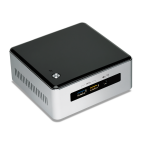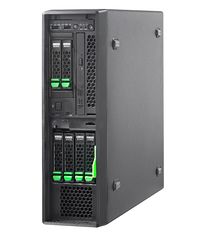Selecting Hardware For Your Anvil!: Difference between revisions
| Line 87: | Line 87: | ||
= Anvil! Nodes = | = Anvil! Nodes = | ||
The more fault-tolerant, the better! | |||
The ''Anvil!'' Nodes host power your highly-available servers, but the servers themselves are totally decoupled from the hardware. You can move your servers back and forth between these nodes without any interruption. If a node catastrophically fails without warning, the survivor will reboot your servers within seconds ensuring the most minimal service interruptions (typical recovery time from node crash to server being at the login prompt is 30 to 90 seconds). | |||
{|style="width: 100%;" | |||
|style="width: 710px"|[[image:Fujitsu_Primergy_RX300-S8_Front-Left.jpg|thumb|left|700px|The beastly Fujitsu Primergy [http://www.fujitsu.com/fts/products/computing/servers/primergy/rack/rx300/ RX300 S8]; Photo by [http://mediaportal.ts.fujitsu.com/pages/view.php?ref=30751&search=!collection4+rx300&order_by=field12&sort=DESC&offset=0&archive=0&k= Fujitsu].]] | |||
|[[image:Fujitsu_Primergy_TX1320-M1_Front-Left.jpg|thumb|center|200px|The rediculously tiny Fujitsu Primergy [http://www.fujitsu.com/fts/products/computing/servers/primergy/tower/tx1320m1/ TX1320 M1]; Photo by [http://mediaportal.ts.fujitsu.com/pages/view.php?ref=34197&search=!collection4+tx1320&order_by=field12&sort=DESC&offset=0&archive=0&k= Fujitsu].]] | |||
|} | |||
The requirements are two servers with the following; | |||
* A CPU with [https://en.wikipedia.org/wiki/Hardware-assisted_virtualization hardware-accelerated virtualization] | |||
* Redundant power supplies | |||
* [[IPMI]] or vendor-specific [https://en.wikipedia.org/wiki/Integrated_Remote_Management_Controller out-of-band management], like Fujitsu's iRMC, HP's iLO, Dell's iDRAC, etc | |||
* Six network interfaces, 1 [[Gbit]] or faster (yes, six!) | |||
* 4 [[GiB]] of RAM and 44.5 GiB of storage for the host operating system, plus sufficient RAM and storage for your servers | |||
Beyond these requirements, the rest is up to you; your performance requirements, your budget and your desire for as much fault-tolerance as possible. | |||
{{note|1=If you have a bit of time, you should really read the section [[AN!Cluster_Tutorial_2#Recommended_Hardware.3B_A_Little_More_Detail|discussing hardware considerations]] from the main tutorial before purchasing hardware for this project. It is very much not a case of "buy the most expensive and you're good".}} | |||
{|style="width: 100%" | {|style="width: 100%" | ||
Revision as of 23:03, 10 November 2016
|
Alteeve Wiki :: How To :: Selecting Hardware For Your Anvil! |
This guide's goal is to provide a high-level overview on how to match appropriate hardware for anticipated loads on your Anvil! platform.
System Requirements
To provide full stack redundancy, there are minimum system requirements. These are not performance requirements, but instead, minimum features and capabilities.
Foundation Pack
The foundation pack consists of redundant power and redundant networking which the Anvil! nodes will sit on top of. They play an integral role in providing full stack redundancy.
The foundation pack's ethernet switches inform that maximum sequential write speed and network bandwidth between the hosted servers and the outside world. As such, care must be taken when selecting equipment to ensure required performance is provided.
Finally, a foundation pack can host two or five Anvil! pairs. Deciding how many pairs you expect to use will determine the capacity of the foundation pack equipment.
UPSes
Two network-connected UPSes are required in order for ScanCore to monitor incoming power states, estimated run time remaining during power outage, charge percentage during recovery and to alert on distorted input power.
Currently, any UPS that supports the APC (Schneider) AP9630 or AP9631 network cards are supported.
 |
 |
If you plan to use a different make or model, please verify that the input voltage and frequency, battery run time and battery charge percentage can be retrieved over the network. If so, please contact us and we'll be happy to work to add support.
Switched PDUs
Two network-switched PDUs are used to provide backup fencing for the Anvil! nodes.
Currently, any APC (Schneider) switched PDU, like the AP7900, are supported. Raritan brand PDUs are also supported, like the PX2-5260A4R.
 |
 |
Other brands may work fine, but may not be ideal due to slow switching times (TrippLite switched PDUs are an example of PDUs that work, but are very slow to switch and confirm states).
If you plan to use a different make or model, please verify that you can turn an outlet on and off, and that you can verify the outlet's current state. If so, please contact us and we'll be happy to work to add support.
Ethernet Switches
Selecting ethernet switches is easier.
The most fundamental requirement is that the switches support VLANs. We strongly recommend stacked switches with 'hitless failover'. That is to say, the switch must allow for members of the stack to leave and be replaced without any interruption to the flow of network traffic.
 |
 |
We recommend (and have the most experience with) Brocade ICX-series switches, but any vendor (Cisco, Dell, D-Link, etc) should be fine, provided the above features are provided.
Striker Dashboards
Striker dashboards server two purposes;
- Host the Striker WebUI
- Host the ScanCore database
The first job requires very little in the way of system resources. The second one, hosting the database, does require more careful consideration.
Generally speaking, you will want to have 8 GiB of RAM or more, an SSD to help with the random database access an Intel Core i5 or equivalent. The Striker dashboard requires two ethernet connections, one to the IFN and one to the BCN. If you wish, four interfaces can be used. If available, Striker's installer will detect the four interfaces and automatically configure active-passive bonding for the two connections.
A server? An appliance!
The Striker dashboard runs like your home router; It has a web-interface that allows you to create, manage and access new highly-available servers, manage nodes and monitor foundation pack hardware.
 |
 |
We have used;
- Small but powerful machines like the Intel Core i5 NUC NUC5i5RYH with a simple Siig JU-NE0211-S1 USB 3.0 to gigabit ethernet adapter.
- On the other end of the scale, we've used fully redundant Fujitsu Primergy RX 1330 M1 servers with four network interfaces. The decision here will be principally guided by your budget and the number of Anvil! pairs you expect to host ScanCore data for.
Striker dashboards are an integral part of the Anvil! platform and are critical in the delivery of Intelligent Availability. As such, you must have two of them. If the machines you use do not have redundant power and/or networking, be sure to connect the first dashboard to the first power rail and ethernet switch and the second dashboard to the second power rail and ethernet switch.
Anvil! Nodes
The more fault-tolerant, the better!
The Anvil! Nodes host power your highly-available servers, but the servers themselves are totally decoupled from the hardware. You can move your servers back and forth between these nodes without any interruption. If a node catastrophically fails without warning, the survivor will reboot your servers within seconds ensuring the most minimal service interruptions (typical recovery time from node crash to server being at the login prompt is 30 to 90 seconds).
 |
 |
The requirements are two servers with the following;
- A CPU with hardware-accelerated virtualization
- Redundant power supplies
- IPMI or vendor-specific out-of-band management, like Fujitsu's iRMC, HP's iLO, Dell's iDRAC, etc
- Six network interfaces, 1 Gbit or faster (yes, six!)
- 4 GiB of RAM and 44.5 GiB of storage for the host operating system, plus sufficient RAM and storage for your servers
Beyond these requirements, the rest is up to you; your performance requirements, your budget and your desire for as much fault-tolerance as possible.
| Note: If you have a bit of time, you should really read the section discussing hardware considerations from the main tutorial before purchasing hardware for this project. It is very much not a case of "buy the most expensive and you're good". |
| Any questions, feedback, advice, complaints or meanderings are welcome. | |||
| Alteeve's Niche! | Alteeve Enterprise Support | Community Support | |
| © 2025 Alteeve. Intelligent Availability® is a registered trademark of Alteeve's Niche! Inc. 1997-2025 | |||
| legal stuff: All info is provided "As-Is". Do not use anything here unless you are willing and able to take responsibility for your own actions. | |||
